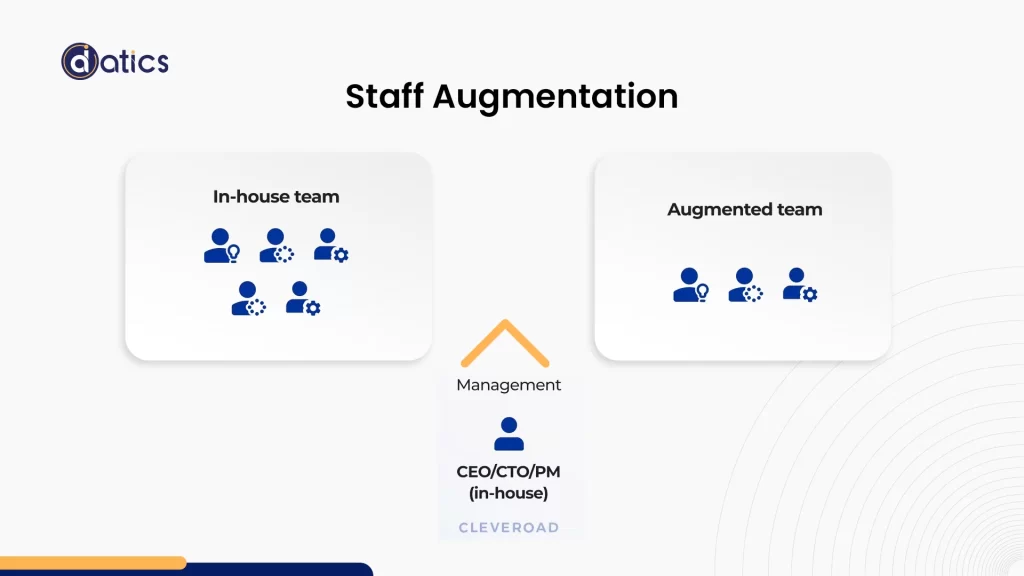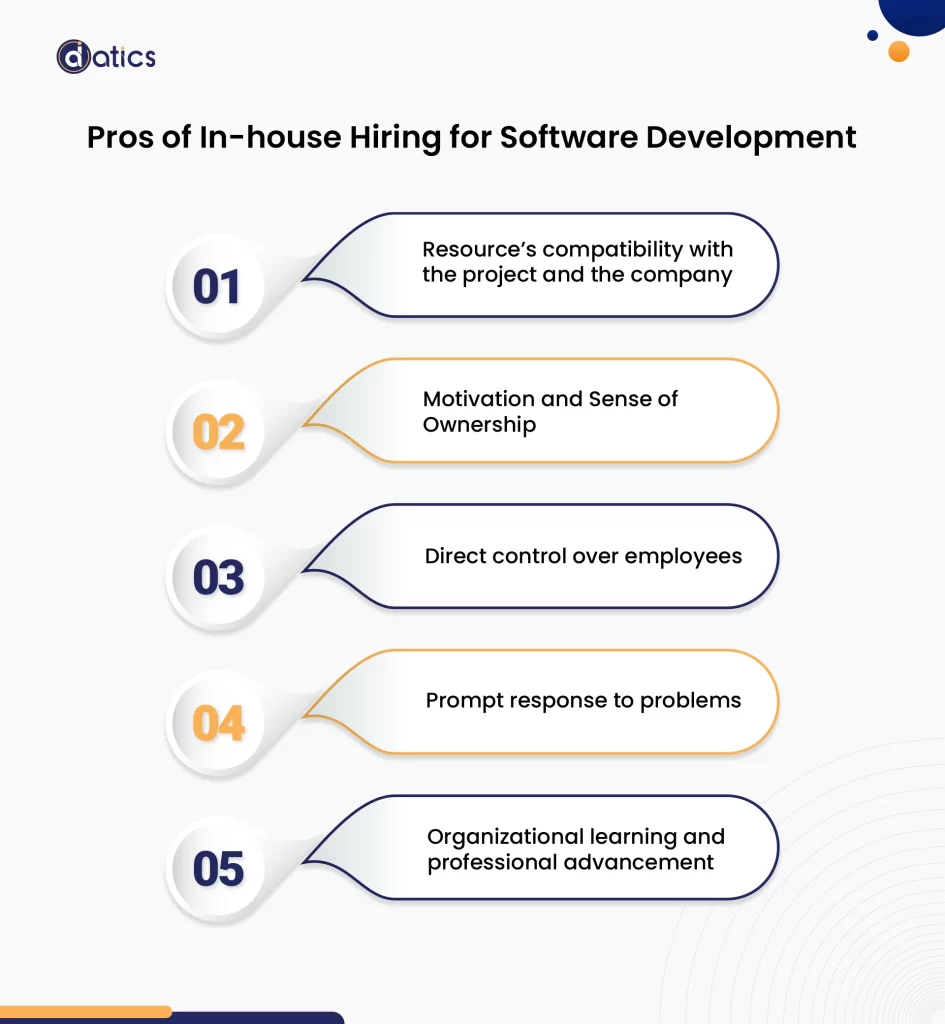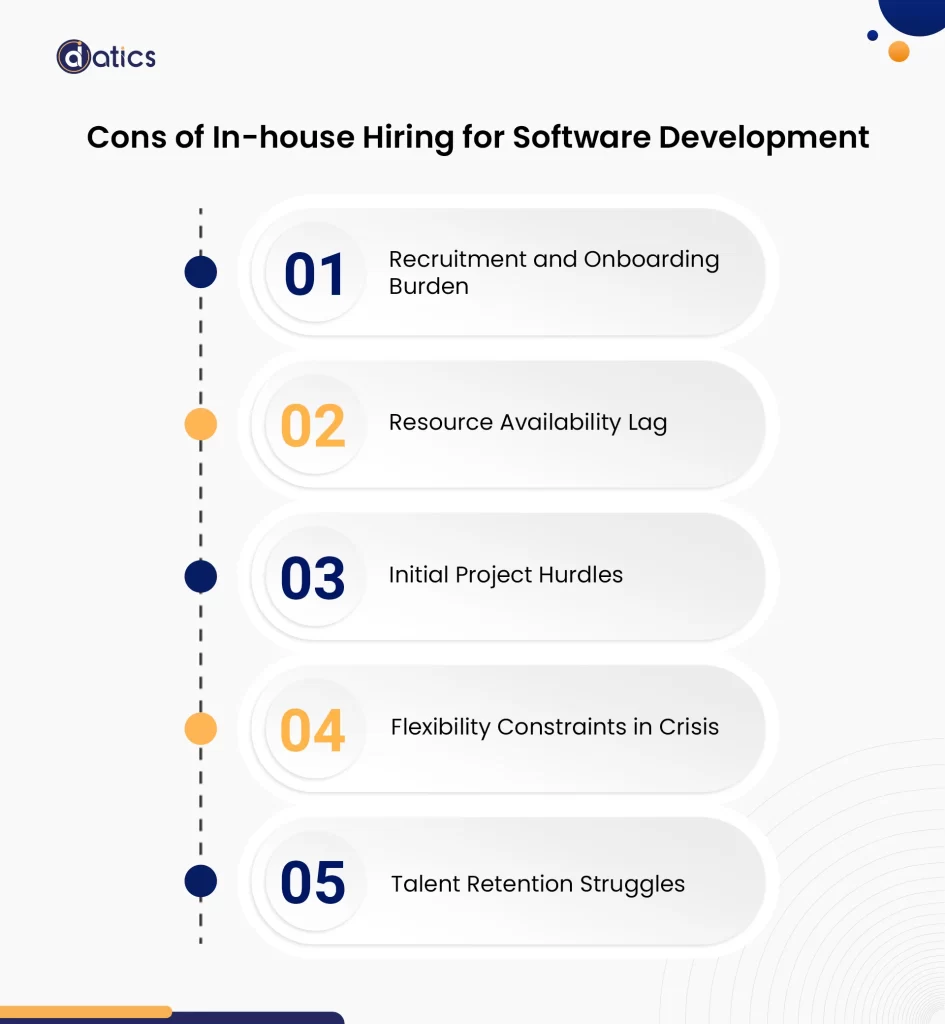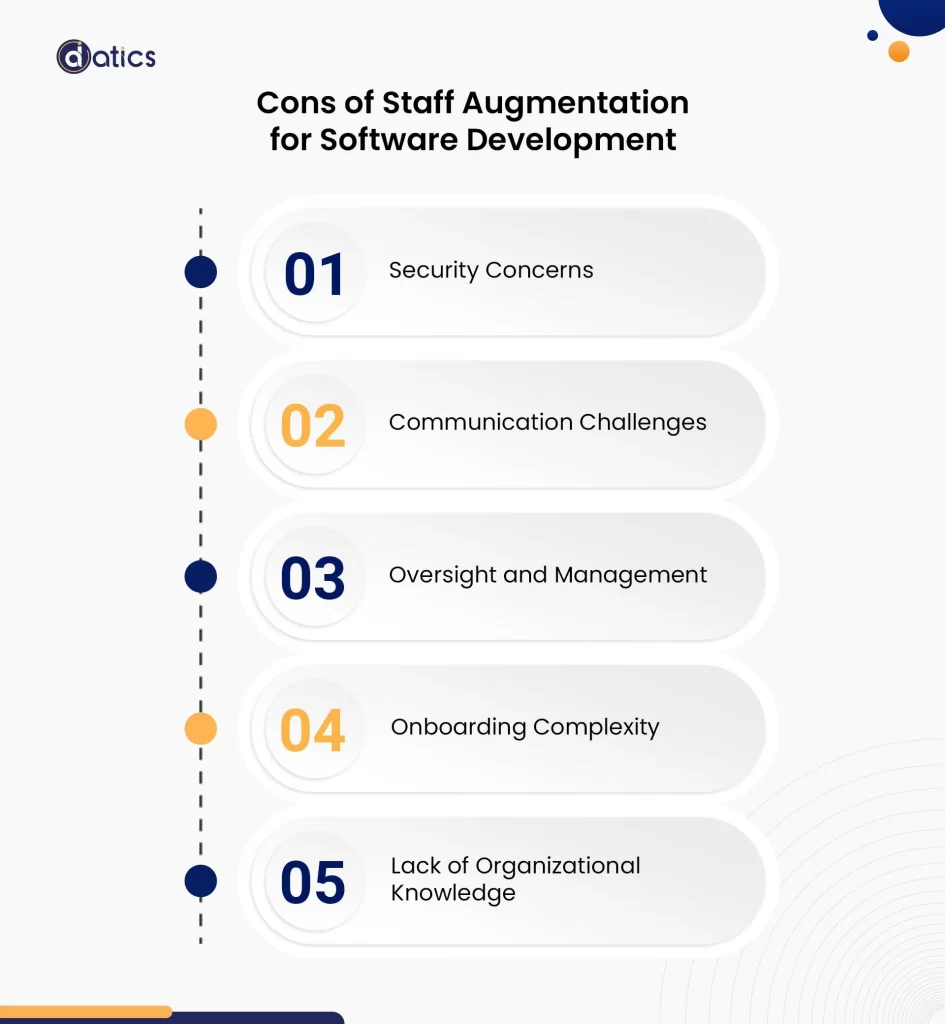
© 2024 | All Right Revered.
A brief comparison of commonly used approaches for software development: In-house IT Resources vs. Staff Augmentation.

Marketing Startegist
A data-driven marketer passionate about empowering businesses through informed decision-making

In 2023, the demand for tech roles skyrocketed, with a projected 272,323 new tech jobs in the US this year. While still lower than the previous year, this figure remained remarkably high.
Throughout the year 2022, US companies advertised over 264,500 tech positions, much higher than from 2021. This surge in demand underscores the critical need for effective hiring practices in the tech industry, especially within the realm of software development.
Balancing factors like time, cost, and talent is pivotal in the complex landscape of software development. Companies require domain experts and seasoned professionals to maintain quality and expedite the development process.
Given these considerations, company leaders often engage in discussions of comparing the pros and cons of hiring in-house IT resources vs. staff augmentation provided by an IT outsourcing partner. Neither option holds a clear advantage; rather, the decision depends on the specific project and context.
This guide will compare the in-house hiring approach with the staff augmentation model. We will explore their respective advantages and disadvantages, as well as the circumstances in which one might prove more beneficial than the other.
Designed to assist decision-makers within businesses and organizations, this guide is tailored for those considering development options for their upcoming tech products. By examining these approaches in detail, you’ll be well-equipped to make an informed decision aligned with your objective.
While establishing an in-house team is a common practice, not everyone is familiar with staff augmentation. So, what does staff augmentation mean?
Staff augmentation is an outsourcing method that enables companies to expand or create teams of skilled tech professionals without the intricacies of hiring full-time staff.
Depending on your needs, you can enhance your existing team by adding a developer (or a few) or set up a dedicated team, all while retaining control over the development process.
Whichever path you choose involves collaborating with a staff augmentation company. They simplify the selection and presentation of potential candidates, streamlining the process of onboarding new team members.
This allows you to swiftly bring in fresh talent without the complications of traditional hiring procedures or the administrative burdens linked to full-time employment.
Though staff-augmented team members aren’t officially full-time employees, they seamlessly blend into your company’s culture, align with your processes, contribute ideas, and work in harmony with your development strategies and goals. This adaptable model offers you the benefits of top-tier talent infusion without the complexities of traditional recruitment.

In-house hiring refers to the traditional practice of recruiting resources internally. Companies follow this approach to build their in-house software development teams.
While there might be cases where specialized projects are outsourced, the core capabilities for software development are held within the organization. This means that companies trust their internal project managers, developers, and specialists to handle software delivery. As a result, in-house hiring provides companies with more control over their teams.
When considering in-house software development, it’s important to weigh its benefits, drawbacks, and fit for your specific business context. This evaluation helps you make an informed decision that aligns with your unique needs.

Opting for in-house hiring enables you to meticulously match talent with your project requirements. Unlike outsourcing, you have the freedom to select candidates based not only on technical skills but also on factors such as company culture and personal preferences.
This tailored approach fosters a stronger connection between your team members and your project.
In-house development teams often exhibit higher levels of motivation.
Why?
Because they are crafting solutions directly for the company they belong to, leading to a profound sense of ownership. Their dedication and commitment translate into a more profound investment in the project’s success.
The ease of direct communication within an in-house team expedites problem-solving. You can timely address technical glitches by leveraging your infrastructure and technology stack. This immediacy ensures a smoother resolution process and minimizes disruptions.
The ease of direct communication within an in-house team expedites problem-solving. You can timely address technical glitches by leveraging your infrastructure and technology stack. This immediacy ensures a smoother resolution process and minimizes disruptions.
Building software in-house serves as a valuable learning experience for both managers and employees. The insights gained from each project cycle contribute to a reservoir of knowledge that can be utilized in future endeavors. This organizational learning enhances the overall capabilities of your organization.

While in-house hiring offers control, it comes with a substantial workload of recruitment and onboarding. This involves advertising job positions, reviewing resumes, conducting multiple interviews, and managing contracts—all before the project even commences.
In contrast, outsourcing providers handle these initial stages, freeing your resources for other priorities.
As mentioned earlier, staff augmentation boasts an array of skilled technical professionals. This extensive talent reservoir expedites hiring processes, allowing swift identification of suitable experts to work on your project.
Staff augmentation broadens your talent search, enabling you to augment your in-house development team with specialists from diverse global regions.
These skilled resources have an agile and efficient approach to software development. The diverse skill set empowers you to select the most suitable engineers for your project, ensuring optimal outcomes.
The dynamic nature of software development often requires flexibility in team size. The staff augmentation model offers a unique advantage in this regard.
Depending on the project’s demands, you can effortlessly scale your team up or down. This flexibility is particularly advantageous when you need to expedite development or temporarily reduce the number of specialists on board due to varying workloads.
The capability to augment your development team as per project requirements enhances project efficiency and cost-effectiveness.
One of the significant benefits of staff augmentation for software development is the quick onboarding of outsourced resources. Traditional in-house recruitment processes can be time-consuming, hampering the project’s momentum.
Staff augmentation enables you to promptly onboard skilled professionals, eliminating lengthy recruitment and onboarding phases. By harnessing the collective expertise of an augmented team, your project can be accelerated without compromising quality.
Staff augmentation empowers you with access to a wide range of technologies and expertise that may not be readily available in your in-house or local talent pool. A notable example is the challenge of hiring professionals for niche technologies.
Locating a MERN developer in your region (USA, Europe & Pacific) might be arduous, but staff augmentation allows you to outsource the global talent and find experts in specific technologies.
This expansive reach ensures that your software development needs are catered to by professionals well-versed in the latest and most relevant technologies.

A significant consideration while augmenting your team is maintaining data privacy and security. This can raise concerns about maintaining control and oversight over the development process. The extent to which you trust your outsourcing partner’s security measures and communication practices is crucial.
To mitigate risks, open dialogue about communication strategies and trust-building measures is recommended. For safeguarding intellectual property and project confidentiality, signing a Non-Disclosure Agreement (NDA) can offer legal protection and peace of mind.
Engaging in a collaborative project across different companies can introduce communication complexities. While language barriers were once a common concern, the prevalence of English-fluent IT specialists has significantly diminished this challenge.
Time zone differences remain an important consideration, but outsourcing vendors typically have strategies to navigate this hurdle effectively. By scheduling meetings in advance or leveraging email and messaging platforms, efficient communication can be maintained despite geographical distances.
While staff augmentation teams often bring specialized skills, they are still new additions to your existing team. Ensuring a smooth onboarding process is vital for fostering effective collaboration and productivity. This involves familiarizing the augmented team with your company’s processes, tools, and culture.
A comprehensive onboarding strategy ensures that the augmented team quickly integrates and contributes to the project’s success.
Some projects demand an intimate understanding of your company’s internal workings or previous projects to deliver the desired results. Augmented employees, although highly skilled, might not possess this internal knowledge.
To address this, comprehensive documentation and knowledge sharing become critical. Providing the augmented team with the necessary background information equips them to align their contributions with your company’s goals and expectations.
Deciding between hiring in-house IT resources vs. staff augmentation is not always a clear-cut decision. What proves effective for one organization might not align with another’s needs. Even within a single company, every project could benefit from different strategies.
What we have learned by working on tons of projects is that a combination of both methods could be advantageous. Employing an in-house team for essential and foundational elements while augmenting your team with outsourced expert resources is a possibility.
Understanding the relevant pros and cons of in-house and outsourcing models as they relate to your company’s requirements is crucial. This will ensure a tailored approach that fits your specific needs.
Here are a few situations where in-house hiring and staff augmentation work best.
Setting up an in-house software development team is a lasting investment in enhancing your company’s skills and expertise. Finding the right candidate is a meticulous process, taking weeks or months. This thorough approach ensures the chosen specialist is an ideal fit.
Additionally, a lack of specific experts can slow down tasks and projects. A shortage of staff limits project scope and achievable goals. In-house hiring suits companies that:
Aim to boost skills long-term.
Have in-house recruiters.
Can dedicate time to a comprehensive search.
Can attract candidates with competitive pay and benefits.
Staff augmentation offers a swift solution when specific skills are needed on a streamlined project. Instead of traditional recruitment, it involves connecting with software development companies providing staff augmentation services. You “hire” specialized professionals from a company’s pool of employees. This process is beneficial for:
If you’re in search of a software development company that offers staff augmentation and more, Datics AI is here for you. Our comprehensive staffing services and expert professionals can seamlessly integrate with your project’s needs.
With an active presence since 2018, we’ve amassed five years of experience in diverse industries. Our track record includes successfully delivering over 50 projects spanning Fintech, Hardware Equipment, Automobiles, Sales, Marketing, Fitness, and Cloud Management.
This breadth of experience equips us to understand your unique project requirements and tailor solutions accordingly.
At Datics AI, we harness a set of tried-and-true technologies. These technologies not only provide efficient and effective development but also contribute to the creation of robust web, desktop, and mobile solutions. This ensures that your project benefits from the latest advancements in the tech landscape.
Communication is key in remote collaboration, and our team excels in this area. Our specialists have undergone thorough English proficiency assessments, guaranteeing effective communication channels between our experts and your team.
Our team boasts a diverse skill set that covers various essential domains. From iOS and Android app development, both native and hybrid, to crafting custom web solutions, cloud solutions, software architecture, quality assurance and testing, DevOps services, and UI/UX design, we’ve got you covered. This expansive expertise ensures that whatever your project demands, we have the right professionals to deliver.
Our commitment to quality is validated through feedback from our clients. You can directly connect with them to gather insights into their experiences. Our collection of awards further underscores the excellence we consistently deliver in our services and solutions.
In today’s fast-paced market, getting your product to market quickly is essential. Datics AI specializes in rapid product launch strategies, including building minimum viable products (MVPs) and creating proof of concept (PoC) solutions. These approaches enable you to gather early user feedback and secure necessary investments for your business venture efficiently.
Share the details of your project – like scope, timeframe, or business challenges. Our team will carefully review them and get back to you with the next steps!

© 2024 | All Right Revered.
This guide is your roadmap to success! We’ll walk you, step-by-step, through the process of transforming your vision into a project with a clear purpose, target audience, and winning features.